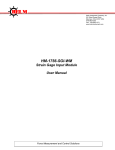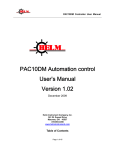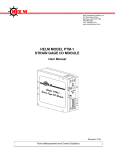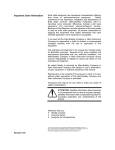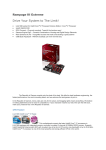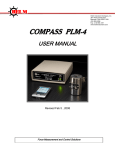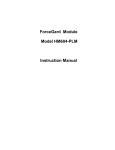Download HM1756 ControlLogix Strain Gage Module
Transcript
Helm Instrument Company, Inc. 361 West Dussel Drive Maumee, Ohio 43537 USA 419/ 893-4356 Fax: 419/ 893-1371 www.helminstrument.com HM-1756-SGI-PLM Strain Gage Input Module User Manual Force Measurement and Control Solutions HM-1756-SGI Operating Instructions IMPORTANT USER INFORMATION....................................................................................................................1 PREFACE ............................................................................................................................................................2 WHO SHOULD USE ............................................................................................................................................2 PURPOSE OF THIS MANUAL .............................................................................................................................2 RELATED DOCUMENTATION.............................................................................................................................3 TERMS AND ABBREVIATIONS...........................................................................................................................3 TECHNIQUES USED IN THIS MANUAL..............................................................................................................5 PRODUCT SUPPORT..........................................................................................................................................5 OVERVIEW ..........................................................................................................................................................6 HARDWARE OVERVIEW ....................................................................................................................................7 HM-1756SIG-PLM SPECIFICATIONS .................................................................................................................7 GETTING STARTED............................................................................................................................................8 REQUIRED TOOLS AND EQUIPMENT ...............................................................................................................8 SYSTEM OPERATION.........................................................................................................................................9 FRONT PANEL ....................................................................................................................................................9 MODULE I/O CONFIGURATION........................................................................................................................10 MODULE I/O CONTROLLER DATA TAGS ........................................................................................................11 CALIBRATING MODULE WITH SENSOR .........................................................................................................15 APPENDIX A: CONTROLLER TAGS .................................................................................................................19 APPENDIX B: SENSOR .....................................................................................................................................20 APPENDIX C: SYSTEM CONNECTION ............................................................................................................21 II HM-1756-SGI Operating Instructions PREFACE IMPORTANT USER INFORMATION Solid state equipment has operational characteristics differing from those of electromechanical equipment. “Safety Guidelines for the Application, Installation and Maintenance of Solid State Controls” (Allen-Bradley Publication SGI-1.1) describes some important differences between solid state equipment and hard-wired electromechanical devices. Because of this difference, and also because of the wide variety of uses for solid state equipment, all persons responsible for applying this equipment must satisfy themselves that each intended application of this equipment is acceptable. In no event will the Helm Instrument Company be responsible or liable for indirect or consequential damages resulting from the use or application of this equipment. The examples and diagrams in this manual are included solely for illustrative purposes. Because of the many variables and requirements associated with any particular installation, the Helm Instrument Company cannot assume responsibility or liability for actual use based on the examples and diagrams. No patent liability is assumed by Helm Instrument Company with respect to use of information, circuits, equipment, or software described in this manual. Throughout this manual we use notes to make you aware of safety considerations. ATTENTION: Please refer to accompanying manuals Strain Gage Installation and Helm ControlLogix Navigator Software for additional information on the application of the Helm HM-1756-SGI-PLM module. ControlLogix, Compact I/O, MicroLogix 1500, PLC, PLC2, PLC3, and PLC5 are registered trademarks of the Allen-Bradley Company, Inc. SLC, SLC500, PanelView, RediPANEL, Dataliner are trademarks of Allen-Bradley Company, Inc. IBM is a registered trademark of International Business Machines, Incorporated. ForceGard is a registered trademark of the Helm Instrument Company, Inc. 1 HM-1756-SGI Operating Instructions PREFACE PREFACE Read this preface to become familiar with the rest of this manual. This preface covers the following topics: Who should use this manual The purpose of this manual Terms and abbreviations Conventions used in this manual Helm Instrument support WHO SHOULD USE Use this manual if you are responsible for the design, installation, programming, or maintenance of an automation control system that uses Allen-Bradley small logic controllers. You should have a basic understanding of ControlLogix products. You should understand electronic process control and be able to interpret the ladder logic instructions required to generate the electronic signals that control your application. If you do not, contact your local Helm representative for the proper training before using this product. PURPOSE OF THIS MANUAL This manual is a learning and reference guide for the Helm ControlLogix Strain Gage Input Module. It contains the information you need to install, wire, and use the module. 2 PREFACE V L O S P R T O W A N E M S R IT E R E R HM-1756-SGI Operating Instructions P IN U T O M D U L E W A R N I (S )3 1 M H 1 5 C M E O A M T C M A S R E I S V A L E N G 3 0 (R )2 (R E R )1 .F G E (S G S . D N )2 4 IE H L D RELATED DOCUMENTATION Additional documents containing information that may be helpful to you as you use Allen-Bradley ControlLogix products may be found at http://www.ab.com/manuals/cl/ or from your local distributor. TERMS AND ABBREVIATIONS The following terms and abbreviations are used throughout this manual. For definitions of terms not listed here refer to Allen-Bradley’s Industrial Automation Glossary, Publication ICCG-7.1. Bypass Mode - Enabled to perform calibration and setup procedures. Calibration - Procedure, performed by trained personnel, where machine or press is dynamically loaded to impact on load cells. A process of linearity measuring to determine the loading capacity of the machine. Calibration Number - Amplification values established during machine calibration or pre-assigned on force load cells. Channel - Refers to one of two, strain gage inputs available on the modules terminal block. Chassis - A hardware assembly that houses devices such as I/O modules, adapter modules, processor modules, and power supplies. Configuration Word - Contains the channel configuration information needed by the module to configure and operate each channel. Information is written to the configuration word through the logic supplied in your ladder program. Data Word - A 16-bit integer that represent the value of the analog input channel. The channel data word is valid only when the channel is enabled. Gain - Amplification of an input signal. Load/Force - Measurement of impact during a machine cycle. Sensors provide the input for this measurement. Look Window - Resolver or cam activated window, which allows specific degrees in a machine cycle to be processed. Low Alarm Inhibit - Number of consecutive machine cycles where low alarm is inhibited. Used in a process where machine cycles several times before running speed is established. LSB - (Least Significant Bit) Refers to a data increment defined as the full scale range divided by the resolution. The bit that represents the smallest value within a string of bits. Monitor Parts Mode - Status condition used during production run. Sample and compare logic is enabled. On resolver based systems, tracking alarm limits can be enabled. Multiplexer - A switching system that allows several input signals to share a common A/D converter. Peak Mode - Normally enabled during job setup. 3 HM-1756-SGI Operating Instructions PREFACE Terms and Abbreviations (Continued) Sampling time - The time required by the A/D converter to sample an input channel. Scale - Value used to describe the press/machine overall tonnage. Set for maximum value of one channel. For example, settings for a 150 ton press = 75. Status Word - Contains status information about the channel’s current configuration and operational state. You can use this information in your ladder program to determine whether the channel data word is valid. Strokes per Minute (SPM) - Value calculated when a machine cycles through a complete rotation (0 to 360 degrees). Update Time - The time required for the module to sample and convert the input signals of all enabled input channels and make the resulting data values available to the controller. 4 HM-1756-SGI Operating Instructions TECHNIQUES USED IN THIS MANUAL The following conventions are used throughout this manual: Bulleted lists such as this one provide information, not procedural steps. Numbered lists provide sequential steps or hierarchical information. PRODUCT SUPPORT Contact your Helm representative or call Helm direct at 419-893-4356: sales and order support product technical training warranty support support service agreements Your Questions or Comments on this Manual If you have any suggestions for how this manual could be made more useful to you, please send us your ideas. 5 HM-1756-SGI Operating Instructions CHAPTER 1 OVERVIEW You have just purchased the most advanced strain gage input module available. HELM INSTRUMENT COMPANY, INC. manufactures a complete line of monitoring control solutions for use on metal stamping, forging, compaction and assembly presses; cold forming, cold heating, injection molding and die cast machines. Resolvers, standard or custom transducers and load cells are available for in-die monitoring of transfer or progressive tooling. At HELM, quality is inherent not only in the design of our products but in the attitudes of our employees as well. We’re working together to give you the best. After all, that’s what our business is all about - providing innovative instrumentation to help make your manufacturing process more productive and your operation more effective. The Helm Strain Gage combines machine and tooling monitoring with programmable limit switch function. User programmable high and low limits protect the machine and tooling to ensure part quality. Critical setup information can be stored and uploaded as part of a die recipe program. An optional resolver input module is used to compare machine/press tonnage to crank angle for real time signature analysis. The Helm Strain Gage module is attached to the controller or to an adjacent I/O module on the din rail. The system is comprised of two parts; the input module and two Helm Strain gage based sensors. The primary part of the load monitoring system centers around the measurement. The basic function of the Helm Strain Gain sensor is to detect the amount of deflection imposed on the press or die as parts are being formed. All Strain Gain sensors are matched to within 1% and therefore can be replaced without recalibration of the machine. The Helm Strain Gain sensors can be mounted to strategic high stress areas of the machine frame or strategically located in tooling or applied to stop blocks. Signals from these sensors are routed to the Strain Gage module for processing. The Helm Strain Gage is capable of measuring either a tension or compression signal. • Sample and Compare Logic - processor memorizes the sample or benchmark load and compares each machine cycle against this sample. • User programmable Sample Count - selectable number of machine cycles on which to base the sample. • High and Low Capacity Alarm Sets - a discrete load limit for a maximum allowable load and a minimum allowable load. • High and Low Trend Alarm Sets - set as a percentage of load change on an established sample. • Low Alarm Inhibit - User programmable option to disable low alarm during process start-up. 6 HM-1756-SGI Operating Instructions CHAPTER 1 HARDWARE OVERVIEW The HM-1756-SGI-PLM module fits into any single-slot. It is a Class 1 module (uses eight input words and eight output words). The module can accept 2 channels of strain gage input. Two 700 ohm gages may be paralleled to one channel. Module configuration requires manual and user programmable setup. The module receives and stores digitally converted analog data into its image table for retrieval. HM-1756-SGI-PLM SPECIFICATIONS Backplane Power Consumption 10W Number of Channels 2 (isolated) I/O Chassis Location Any I/O module slot except 0 A/D Conversion Method Successive Approximation - 12 bit Normal Mode Rejection (between + input and - input) 50 db at 2000 gain AMP roll-off frequency 650 Hz at 3000 Gain Calibration Manual Calibration Isolation 500 VDC continuous between inputs and chassis ground, and between inputs and backplane LED Indicators STATUS, ALARM, OK Recommended Cable Strain Gage Cable (Helm part number 6117) Operating Temperature 0°C to 60°C (32°F to 140°F) Hazardous Environment Classification Class 1 Division 2 Hazardous Environment Type of Input Strain Gage (350 ohm, 700 ohm) Input Impedance 1K Display Resolution Up to 0.1% of full scale Overall Module Accuracy 1% of full scale Requested Packet Interval (RPI) 60.0ms 7 CHAPTER 2 V L O S R T P N A W O S M E T I R E R E R HM-1756-SGI Operating Instructions P IN T U O M U D E L W R A IN (R (E R (S M H G N )2 ).1 F G E . D N )2 4 S IE H (S )3 1 5 1 0 3 D L GETTING STARTED This chapter can help you to get started using the Helm Strain Gage module. The procedures included here assume that you have a basic understanding of ControlLogix products. You should understand electronic process control and be able to interpret the ladder logic instructions required to generate the electronic signals that control your application. Because it is a start-up guide, this chapter does not contain detailed explanations about the procedures listed. It does, however, reference other chapters in this book where you can get more information about applying the procedures described in each step. It also references other documentation that may be helpful if you are unfamiliar with programming techniques or system installation requirements. If you have any questions or are unfamiliar with the terms used or concepts presented in the procedural steps, always read the referenced chapters and other recommended documentation before trying to apply the information. This chapter will: • • • tell you what equipment you need explain how to install and wire the module show you how to calibrate the module REQUIRED TOOLS AND EQUIPMENT Have the following tools and equipment ready: • small blade screwdriver • programming equipment (All programming examples shown in this manual demonstrate the use of Rockwell RSLogix 5000 Software). • Helm CAM/ Prox Input Module 8 CHAPTER 2 HM-1756-SGI Operating Instructions SYSTEM OPERATION The module communicates to the controller through the serial backplane interface and receives +5Vdc and +24Vdc power from the controller power supply through the backplane. No external power supply is required. You may install as many modules in your system as the power supply can support. FRONT PANEL STRAIN GAGE INPUT STATUS OK ALARM STATUS / ALARM INDICATOR LIGHTS ANALOG RESOLVER / CAM INPUT RES. IN ANALOG RESOLVER / CAM OUTPUT RES. OUT STRAIN GAGE INPUT CONNECTOR CH1 GAIN AUTO-ZERO OFF POSITION CALIBRATE CH1 BALANCE +S CH1 SHIELD -S CH1 "LOOK WINDOW" & CH.1 OUTPUT +GAGE TIMING WINDOW -GAGE +S CH2 SHIELD CH.1 & 2 ANALOG OUTPUT ANALOG OUT STOP OUTPUT STOP HIGH - LOW GAIN SWITCH GN SW -S CH2 CH2 GAIN AUTO-ZERO OFF POSITION CALIBRATE CH2 BALANCE HELM INSTRUMENT CO., INC. MAUMEE, OHIO USA (419) 893-4356 Status / Alarm Indicator Lights Status light is on (green) when module is in Peak or Monitor Parts Mode. Status light is off when module is in Calibrate Mode. Alarm light is off when no tonnage fault is present. Alarm light is on (red) when tonnage fault is present. OK light is on (green) when PLC communication is OK. Module Setup All values are 0 (default) on initial start-up. This means that all alarms are disabled. You must make the following adjustments for proper operation: • • • • • set operating mode set meter scale set capacity (maximum load) alarms set sample count set trend alarms 9 HM-1756-SGI Operating Instructions MODULE I/O CONFIGURATION This shows the preliminary setup and operation required before the module can function in a 1756 I/O system using RSLogix5000 Adding Module to I/O Configuration Select 1756-MODULE Generic Module from Select Module Type window Configuration Module’s Properties From the Controller Organizer, windows right click on the added module and open up Module Properties Type in a name for the module, select a slot number 10 HM-1756-SGI Operating Instructions General: Connection Parameters Assembly Instance Input 100 Output 190 Configuration 1 Size 14 9 0 Connection: Requested Packet Interval(RPI): 60.0ms MODULE I/O CONTROLLER DATA TAGS Output Tags The 9 word output data (output from the CPU to the module) contains Information that you configure to define the way the module will work. Example – If you want to access the module located in slot 2 in the ControlLogix chassis, your data tag would be Local:2:O and all 9 words are located as Loca:2:O.Data[0] ..[8] Data Tags Local:x.O .Data[0] .Data[1] .Data[2] .Data[3] .Data[4] .Data[5] .Data[6] .Data[7] .Data[8] Data Type Bit Bit Bit Bit Bit Bit Bit INT INT INT INT INT L Byte H Byte L Byte H Byte Bit Bit Bit Bit Bit Bit Bit Bit H Byte Bit 0 1 2 8 9 10 11 0 1 2 3 4 5 6 7 - Description Alarm Reset Set Calibrate mode Set Setup mode Set Monitor Mode Set Scale Value Set Ch1 High Capacity Alarm Value (in Calibrate mode) Set Ch2 High Capacity Alarm Value (in Calibrate mode) Set Sample Count (2, 4, 8, or 16) Set Low Alarm Inhibit Count Set Ch1 Low Tolerance value Set Ch1 High Tolerance value Set Ch2 Low Tolerance value Set Ch2 High Tolerance value Set Trend Alarm On/Off switch bit Set Tolerance value type (1 = Tolerance in Ton, 0 = Tolerance in Percent) X: slot number Alarm Reset Bit Set this bit On(1) for at least 50ms or longer to clear all present alarm condition of the module. Set Calibrate Mode Bit Set On (1) to change the operation mode to Calibration mode. No alarms are active. Note: all other mode bit must be off 11 HM-1756-SGI Operating Instructions Set Peak Mode Bit Set On (1) to change the operation mode to Setup (peak only monitoring) mode. Capacity alarms are active. Note: all other mode bit must be off Set Monitor Parts Mode Bit Set On (1) to change the operation mode to Monitor parts (trend monitoring) mode. Capacity alarms are active, trend alarms are active. Note: all other mode bit must be off Set Scale Value The maximum load rating of the machine per channel. For example, if the machine is rated at 500ton max and two load sensors are installed for the module, then the scale set should be 250. Set Ch1(2) High Capacity Alarm Value Integer value of high capacity alarm setting. Range = 0 to 9999. A value of 0 disables alarm. The value entered will not be valid in the module until in Calibrate mode. Set Sample Count Enter one of the numbers 2, 4, 8,or 16. This is the number of cycles for the module to take to learn new sample(Target) tonnage for Trend alarm feature. Set Low Alarm Inhibit Count Enter a number of cycles for module to inhibit low trend alarm when sampling is done in Monitor mode. To disable this feature, enter ’0’ Set Ch1(2) High/Low Tolerance Value Integer values of high and low limit for trend alarm settings. Values are set in percent or in ton and represent the maximum and minimum percent/ton of change off the sample value. Range = 0 to 99%. Or 0 to 255ton. Actual value need to be entered is: High Tol x 256 + Low Tol A value of 0 disables alarm. Set Trend Alarm On/Off switch bit When set on (1), Trend alarm is active in Monitor part. Set off to disable it. Set Tolerance value type bit When set on(1), the module takes the High/Low Tolerance value setting as ton. When set off(0), the module takes the High/Low Tolerance value setting as percent. 12 HM-1756-SGI Operating Instructions Input Tags The 14-word module input image (input from the module to the processor) represents data words and status words. Data words hold the input data that represents the values of the sensor inputs. Status words contain the various status conditions of the module Data Tags Local:x.I .Data[0] .Data[1] .Data[2] Data Type INT INT INT Bit .Data[3] INT - .Data[4] .Data[5] .Data[6] .Data[7] .Data[8] .Data[9] .Data[10] INT INT INT INT INT INT Bit .Data[11] Bit .Data[12] .Data[13] INT INT 0 1 2 3 4 5 0 1 2 3 4 5 6 - - Description Update Counter ASIC Fault Code Ch1 Peak value in Ton (in PEAK or MONITOR Mode) Ch1 Calibrate number (in CALIBRATE Mode) Ch2 Peak value in Ton (in PEAK or MONITOR Mode) Ch2 Calibrate number (in CALIBRATE Mode) Ch1 Trend deviation in Percent or Ton Ch2 Trend deviation in Percent or Ton Ch1 Sample value in Ton Ch2 Sample value in Ton Ch1 Reverse Load in Ton Ch2 Reverse Load in Ton Ch1 High Trend Alarm Indication Bit Ch1 Low Trend Alarm Indication Bit Ch2 High Trend Alarm Indication Bit Ch2 Low Trend Alarm Indication Bit Ch1 Capacity Alarm Indication Bit Ch2 Capacity Alarm Indication Bit Module In Calibrate Mode Indication Bit Module In Peak Mode Indication Bit Module In Monitor Mode Indication Bit Sampling in progress Indication Bit Sample Ready Indication Bit (stay On until the mode changes) Alarm Rest in progress bit CAM Trigger toggle bit Cycle Counter CAM Signal Update Counter Update Counter increments by one when every time the Input image tag has been updated with new data from the module. ASIC Fault Code Reserved for firmware trouble shoot. Ch1(2) Peak value in Ton / Calibrate number Integer word represents peak load on channel 1(2) for current machine cycle in Peak and Monitor Mode. In Calibrate mode, this displays the sensor input balance when the three-position switch is set to OFF (center) position on the front of panel of the module. When the three-position switch is set to Calibrate (down) position, this displays the sensor’s calibration(gain) number. Ch1(2)Trend Deviation in Percent or Ton Integer word represents the difference between current peak load and sample peak load. in percentage or tonnage. This value can be used to control Trend deviation LED type display. (Only valid in Monitor mode) Ch1(2) Sample value in Ton Integer word represents the average of the load values in Tons when learning(sampling) cycle is completed in Monitor mode. Ch2 Reverse Load in Ton Integer word represents the peak reverse load value in tons for the current machine cycle. 13 HM-1756-SGI Operating Instructions Capacity Alarm Indication Bit When on (1), the current load of the channel has met or exceeded the Capacity alarm set limit. High Trend Indication Alarm Bit When on (1), the current peak load has met or exceeded the high tolerance percentage or tonnage setting from the sample tonnage. High Trend Indication Alarm Bit When on (1), the current peak load has met or become below the low tolerance percentage or tonnage setting from the sample tonnage. Module In Calibrate Mode Indication Bit This bit is reported by the module that the module is actually in Calibration mode when On(1) Module In Peak Mode Indication Bit This bit is reported by the module that the module is actually in Peak mode when On(1) Module In Monitor Mode Indication Bit This bit is reported by the module that the module is actually in Monitor mode when On(1) Sampling in progress Indication Bit This bit is reported by the module that the module is currently in learning(sampling) mode when On(1) Sample Ready Indication Bit (stay On until the mode changes) This bit is reported by the module that the module completed the learning cycle and established new sample tonnage when On(1) Alarm Rest in progress bit This bit is reported by the module that the module is currently resetting all alarm conditions when On(1) CAM Trigger Toggle bit This bit toggles between 0 and 1 when there is a state change of the CAM input from low to high. If there is no CAM input state change, the bit remains the same as the last bit state. 14 CHAPTER 3 HM-1756-SGI Operating Instructions CALIBRATING MODULE WITH SENSOR WIRING SENSOR(S) (CH 1) + SIGNAL (WHITE) (CH 1) NOISE DRAIN (SHIELD) (CH 1) – SIGNAL (RED) BOTH + GAGE (BLACK) BOTH – GAGE (GREEN) (CH 2) + SIGNAL (WHITE) Green (+ Gage) Black (- Gage) White (+ Signal) Red (- Signal) Brown (Shield) 15 Tension Operation Compression Operation Green Black White Red Shield Black Green White Red Shield HM-1756-SGI Operating Instructions Connecting CAM Input for Look Window Timing Connect Helm CAM/ Prox. Input Module to the HM1756SGI module with provided Coax Cable. 24VDC timing input needs to be connected to CAM Input Module for Peak load window timing. Refer to APPENDIX C for the connection details. Note: Helm CAM/ Prox Input Module provide clean and reliable timing signal for the HM1756 Module which allows the HM1756SIG module functioning properly over 1000 SPM machine operation. Set the Run mode bit to Bypass ⇒ From your operator interface, put the tonnage module into bypass mode. (The STATUS light on the tonnage module will turn off). Balance Sensor Input. 1. Set three-position switch to OFF (center) position. 2. Adjust balance potentiometer until 0’s are all displayed from Local:x:I.Data[2] for Ch1, Local:x:I.Data[3] for Ch2 3. If two sensors are wired, follow this procedure for both channels Calibration Numbers 1. Set three-position switch to calibrate (down) position) 2. Adjust Gain Potentiometer to dial in calibration numbers. These number is displayed at Local:x:I.Data[2] for Ch1, Local:x:I.Data[3] for Ch2 3. If two sensors are wired, follow this procedure for both channels. Always make sure that the three-position switch is in ON (top) position for Normal operation. The remaining setup procedures can be accomplished with the Run Mode bit in either Bypass, Peak or Monitor Parts Mode. However, the Bypass Mode should only be used when setting calibration values or zero balancing the sensor input. 16 HM-1756-SGI Operating Instructions Set Machine Capacity Scale The three position switch should be placed in the ON (top) position. This setting is based off of one channel. It represents the maximum allowable load or tonnage from one sensor location. Setting Machine Capacity Scale using (1) two channel module: If 2 sensors are installed on the left and right sides of a 60 ton press, set the Scale to 30 (maximum capacity of one sensor). Use the following table as a reference for setting the Machine Capacity Scale for a single force module installation with two sensors. Divide the press/machine capacity by the number of sensors (2) and set Scale to the result. PRESS CAPACITY 20 45 80 SCALE SETTING 10 22 40 PRESS CAPACITY 30 50 110 SWITCH SETTING 15 25 55 PRESS CAPACITY 40 60 150 SWITCH SETTING 20 30 75 100 250 125 300 150 ... 200 If 2 sensors are installed in the tooling rather than on the press structure, set the Machine Capacity Scale to the highest load/tonnage of one sensor. Setting Machine Capacity Scale for multiple channel systems. Divide the Machine capacity by the number of sensors and set Machine Capacity Scale on all modules to the result. Example: If 2 load modules are used for monitoring a straight side press with 4 sensors mounted on the press columns, set the Machine Capacity Scale on both modules to the highest load/tonnage of one sensor. Use the following table as a reference for setting the Machine Capacity Scale for a system comprised of (2) force modules and (4) sensors. PRESS CAPACITY 100 175 275 400 ... 800 SWITCH SETTING (same on all modules) 25 43 68 100 PRESS CAPACITY 125 200 300 450 SWITCH SETTING (same on all modules) 31 50 75 112 200 1000 250 PRESS CAPACITY 150 250 350 500 1200 17 SWITCH SETTING (same on all modules) 37 62 87 125 300 HM-1756-SGI Operating Instructions Set Capacity Alarms This value is a discrete load/tonnage value, not a percentage. NOTE: Although the range of values for capacity alarm settings is 0 to 9999, it is recommended that you do not enter values that exceed the capacity rating of the machine/press. A value of 0 disables capacity alarm set. To determine the maximum rating for each channel, divide the total machine/press capacity by the number of sensor inputs. EXAMPLE: A press or slide rated at 100 tons with a (2) channel force module would have a capacity alarm setting of 50 tons per sensor input. This setting differs from the Scale setting as it can be adjusted up or down depending on the nature of the process. The recommended maximum value is 195% of Machine Capacity Scale. Set Sample Count The sample count is a user programmable parameter that tells the processor how many machine strokes are required to establish sample or benchmark load values. The programmable values are 2, 4, 8,or 16. A value of 0 invalidates the Monitor Parts mode. You should set Sample Count to a minimum of 2 to enable Monitor Parts mode. Note: Each time you change Monitor Parts mode bit from ON to OFF, the sample value is cleared. During normal operations, Monitor Parts mode is enabled when beginning a process run. If the process varies due to change in material thickness, for example, it may be necessary to take a new sample. 18 HM-1756-SGI Operating Instructions APPENDIX A: CONTROLLER TAGS OUTPUT TAGS Data Tags Local:x.O .Data[0] .Data[1] .Data[2] .Data[3] .Data[4] .Data[5] .Data[6] .Data[7] .Data[8] Data Type Bit Bit Bit Bit Bit Bit Bit INT INT INT INT INT L Byte H Byte L Byte H Byte Bit Bit Bit Bit Bit Bit Bit Bit H Byte Bit 0 1 2 8 9 10 11 0 1 2 3 4 5 6 7 - Description Alarm Reset Set Calibrate mode Set Setup mode Set Monitor Mode Set Scale Value Set Ch1 High Capacity Alarm Value (in Calibrate mode) Set Ch2 High Capacity Alarm Value (in Calibrate mode) Set Sample Count (2, 4, 8, or 16) Set Low Alarm Inhibit Count Set Ch1 Low Tolerance value Set Ch1 High Tolerance value Set Ch2 Low Tolerance value Set Ch2 High Tolerance value Set Trend Alarm On/Off switch bit Set Tolerance value type (1 = Tolerance in Ton, 0 = Tolerance in Percent) INPUT TAGS Data Tags Local:x.I .Data[0] .Data[1] .Data[2] Data Type INT INT INT Bit .Data[3] INT - .Data[4] .Data[5] .Data[6] .Data[7] .Data[8] .Data[9] .Data[10] INT INT INT INT INT INT Bit .Data[11] Bit .Data[12] .Data[13] INT INT 0 1 2 3 4 5 0 1 2 3 4 5 6 - - Description Update Counter ASIC Fault Code Ch1 Peak value in Ton (in PEAK or MONITOR Mode) Ch1 Calibrate number (in CALIBRATE Mode) Ch2 Peak value in Ton (in PEAK or MONITOR Mode) Ch2 Calibrate number (in CALIBRATE Mode) Ch1 Trend deviation in Percent or Ton Ch2 Trend deviation in Percent or Ton Ch1 Sample value in Ton Ch2 Sample value in Ton Ch1 Reverse Load in Ton Ch2 Reverse Load in Ton Ch1 High Trend Alarm Indication Bit Ch1 Low Trend Alarm Indication Bit Ch2 High Trend Alarm Indication Bit Ch2 Low Trend Alarm Indication Bit Ch1 Capacity Alarm Indication Bit Ch2 Capacity Alarm Indication Bit Module In Calibrate Mode Indication Bit Module In Peak Mode Indication Bit Module In Monitor Mode Indication Bit Sampling in progress Indication Bit Sample Ready Indication Bit (stay On until the mode changes) Alarm Rest in progress bit CAM Trigger toggle bit Cycle Counter CAM Signal 19 HM-1756-SGI Operating Instructions APPENDIX B: SENSOR 20 LOGIX 5563 21 +24V (RETURN) (PLC Common) BLACK BLUE INSTRUMENT CO., INC. MAUMEE, OHIO USA 0V DRY-CONTACT CAM SWITCH +24V 0V BLUE 0V (RETURN) (RETURN) BLACK THIS DRAWING AS WELL AS THE SUBJECT MATTER THEREON IS EXCLUSIVE PROPERTY OF HELM INSTRUMENT CO., INC. IT IS TO BE TREATED BY YOU AS CONFIDENTIAL, PROPRIETARY INFORMATION. THE DRAWING OR SUBJECT MATTER THEREOF SHALL NO BE DUPLICATED OR DISCLOSED WITHOUT THE EXPRRESS WRITTEN CONSENT OF HELM INSTRUMENT CO., INC. +24V PLC OUTPUT OUTPUT (PLC Common) + BLACK BLUE RES. OUT RES. OUT 2-WIRE PROX PROBE RES. IN STAT ALARMOK 1756-SGI RES. IN STAT ALARMOK 1756-SGI STRAIN GAGE INPUT STRAIN GAGE INPUT (PLC Common) 24 VDC PLC OUTPUT * "Cam" Timing Input Options Alarm Output/Auxillary Input Cable 75W 24V DC POWER ALLEN BRADLEY 1756-PB75 POWER SUPPLY DRAWING NUMBER: E1094W05A R.J.G. HM 1756-SG1 PLM SYSTEM CONNECTIONS (HELM) DRAWER: APPROVED BY: TITLE: N.F.N. CHECKED BY: M.H.L. 02/11/05 DRAWN BY: DATE: Y.K.K. BLACK DESIGNED BY: * BROWN 1.) This output is Solid State 2.) Output Rating = .25 amps @ 24Vdc Notes: NONE "CAM" Timing Input PLC Common Alarm Output SCALE: Last Rev. 12/07/05 BLUE BLACK BROWN ALARM OUTPUT / TIMING INPUT External I/O Connection (Same to Ch's 3 & 4) (2) Strain Gage Inputs, Ea. Module NOTES: Drawing shows HELM model 1756-SGI Strain Gage Modules, necessary related components, and associated interconnecting wiring. HELM Model "HM 1756-SGI" PLM System Connections HM-1756-SGI Operating Instructions APPENDIX C: SYSTEM CONNECTION























